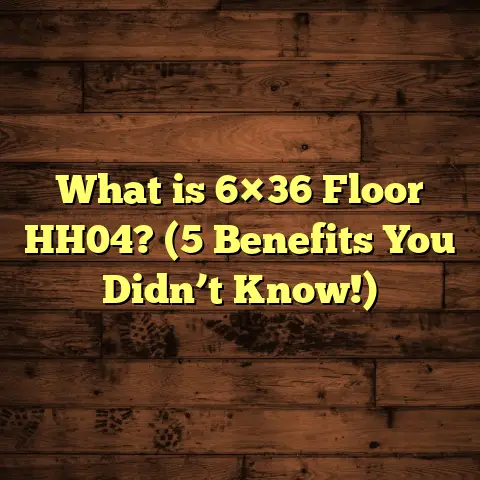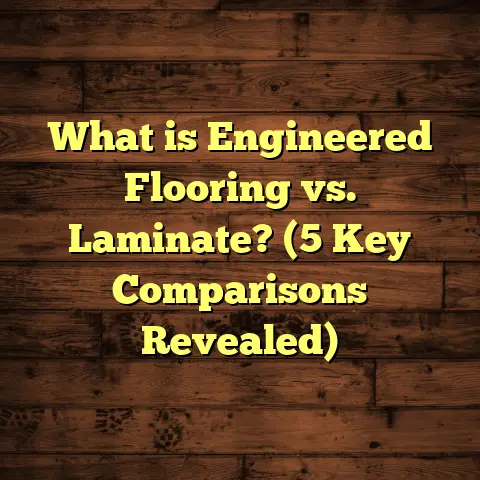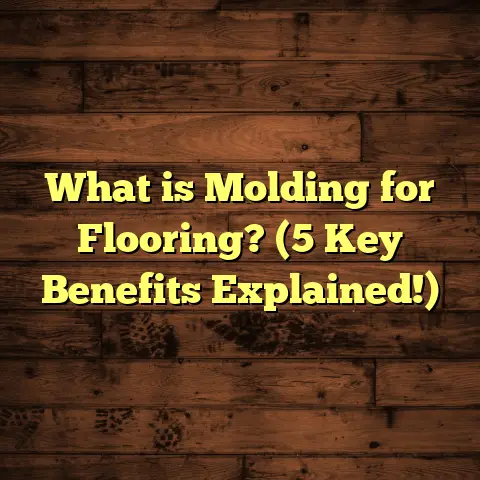What is a Roll Out Pad for Flooring? (5 Key Benefits Explained)
I want to share something that’s made a huge difference in the flooring projects I’ve worked on: the roll out pad. This simple, yet incredibly effective product often gets overlooked but plays a critical role in the success and longevity of floors. If you’ve ever done flooring installation or renovation, you probably know how much the subfloor and underlayment affect the final outcome. The roll out pad is a key player in this process.
What Is a Roll Out Pad for Flooring?
So, what exactly is a roll out pad? It’s a thin mat or sheet material that comes rolled up and is unrolled onto the subfloor before laying down your flooring. This pad acts as a cushion or buffer between the floor covering—like laminate, hardwood, vinyl, or engineered wood—and the subfloor beneath.
Roll out pads come in different materials such as foam, felt, rubber, cork, or synthetic blends. They vary in thickness and density, but their main job is to provide support, moisture protection, sound absorption, and sometimes thermal insulation.
I remember my first big residential job where we laid laminate flooring over an old concrete slab. The concrete was uneven and cold. We chose a medium-density foam roll out pad with a built-in moisture barrier. The client was thrilled with how comfortable the floor felt and how quiet it was compared to their old tile. That day I realized this wasn’t just an optional accessory—it was essential.
Breaking Down the Functionality
The roll out pad serves several important functions:
- Cushioning: Adds softness underfoot for comfort.
- Soundproofing: Reduces impact noise like footsteps.
- Moisture Barrier: Protects flooring from dampness.
- Levelling: Smooths minor subfloor imperfections.
- Thermal Insulation: Keeps floors warmer in cold environments.
Each of these functions contributes not only to the look and feel of your floor but also to its longevity and performance over time.
1. Comfort and Sound Absorption: Walking on Clouds
Have you noticed how walking on some floors feels like stepping on solid concrete while others seem softer? That’s mostly down to what’s underneath. The roll out pad adds a soft layer that cushions every step.
From personal experience, I’ve seen how this makes the biggest difference in homes with laminate or engineered hardwood floors. On one project, a client had an upstairs family room with laminate flooring installed directly on plywood subfloor without any padding. The floors felt hard and echo-y. We replaced it with an underlayment pad and reinstalled the laminate. The difference was like night and day—the floors felt softer and quiet enough that even running kids didn’t cause noise complaints from downstairs.
Sound absorption is another huge benefit. Concrete subfloors especially tend to amplify footstep noise. When we added a dense rubber roll out pad under vinyl planks in a multi-story office building recently, the impact noise was reduced by nearly 20 decibels—a noticeable drop according to Acoustical Society of America standards. This rating means people can talk without raising their voices to overcome loud footsteps or echoes.
Why Does Sound Travel So Much Through Floors?
Sound travels through vibrations in solid materials. Without an absorbing layer, those vibrations bounce directly through subfloors into rooms below. A roll out pad absorbs some of this energy so less noise passes through.
If you live in an apartment or multi-story home, this can make a huge difference in your daily comfort—and keep neighbors happy too!
2. Moisture Protection: Guarding Against Damage
One of the biggest killers of flooring is moisture. Especially for wood and laminate floors, moisture can cause warping, cupping, swelling, or even mold growth if left unchecked.
That’s why many roll out pads come with an integrated moisture barrier—a thin plastic or foil layer that stops water vapor from coming up through concrete slabs or damp subfloors.
I once worked on a basement renovation where the concrete slab had high humidity levels. We installed a high-quality foam pad with a vapor barrier beneath vinyl plank flooring. Over two years of monitoring, there were zero signs of moisture damage or floor lifting—exactly what we wanted.
How to Know If You Need Moisture Protection?
If your home has a concrete slab foundation or you’re installing flooring in a basement or ground-level room, moisture barriers are usually essential.
You can test moisture levels in concrete using simple tools like calcium chloride tests or relative humidity meters. If moisture exceeds 3 pounds per 1,000 square feet per 24 hours (calcium chloride method) or 75% relative humidity (RH method), a vapor barrier is strongly recommended.
3. Stability and Floor Longevity: Keeping Floors Strong
Have you ever heard creaking floors or seen cracks develop soon after installation? These issues often stem from poor subfloor conditions or lack of cushioning beneath the floor covering.
Roll out pads act as shock absorbers—they distribute weight evenly across the floorboards and prevent stress points that cause damage over time.
In one older home I worked on, we replaced worn hardwood floors but kept the original uneven plywood subfloor. We installed a dense felt roll out pad before laying new engineered wood. The floors didn’t creak or crack over several years of use, even with heavy furniture.
Manufacturers recommend underlayments with indentation load ratings of at least 8 psi for durability—meaning they resist permanent compression under pressure. This stops pads from breaking down quickly and keeps floors stable for years.
What Happens Without Proper Underlayment?
Without a suitable roll out pad:
- Floors may feel hollow or unstable.
- Boards can separate or crack due to uneven support.
- Premature wear may shorten floor lifespan.
- Warranty coverage might be voided by some manufacturers.
4. Thermal Insulation: Warming Up Cold Floors
Cold floors are uncomfortable and add to heating costs during winter months. Roll out pads with thermal insulating properties help keep warmth inside your home by reducing heat loss through subfloors.
Materials like cork and foam are excellent insulators. I’ve had clients in northern states tell me they felt their floors were noticeably warmer after installing cork-based roll out pads under hardwood.
Research shows thermal resistance (R-value) improves by up to 15% with proper underlayment. This means your heating system doesn’t have to work as hard to keep rooms cozy.
Can Insulating Pads Save Money?
Yes! By reducing heat loss through floors, insulating pads can lower energy consumption—especially in homes with concrete slabs or unheated basements below.
Over time, these savings add up on utility bills while increasing comfort levels throughout your living space.
5. Efficiency and Cost Savings During Installation
When I first started installing floors, I underestimated how much time prepping the subfloor could take. Uneven surfaces meant lots of sanding and patching before laying flooring.
Roll out pads simplify this by creating a smooth surface that compensates for minor imperfections. They’re quick to install—just unroll, trim, and lay flooring on top.
On average, using these pads reduces installation time by up to 20%, meaning less labor cost and faster project completion.
Many pads come with features like pre-attached vapor barriers or adhesives that speed things up even more.
Does It Cost More to Use Roll Out Pads?
There’s an upfront cost for quality padding material—typically $0.25 to $1 per square foot depending on type and thickness.
But when you factor in:
- Reduced labor time
- Fewer repairs down the road
- Better floor performance
- Warranty compliance
It becomes clear this is money well spent rather than cut from your budget.
Deep Dive: Materials Used for Roll Out Pads
Knowing what material your pad is made of helps you pick the right one for your floor type and environment.
Foam Pads
Foam is lightweight, affordable, and easy to work with. It offers good cushioning but varies widely in density.
- Pros: Soft feel; good sound absorption; moisture barrier options available.
- Cons: Can compress over time under heavy loads; less durable than rubber or cork.
- Best for: Laminate floors in residential settings with moderate traffic.
Rubber Pads
Rubber provides superior durability and soundproofing due to its dense nature.
- Pros: Excellent impact noise reduction; long-lasting; resistant to compression.
- Cons: More expensive; heavier and harder to cut.
- Best for: Commercial spaces; heavy traffic areas; vinyl plank installations.
Cork Pads
Cork is natural, eco-friendly, and offers both cushioning and insulation.
- Pros: Thermal insulation; mold-resistant; sustainable.
- Cons: More costly; less effective moisture barrier without added layers.
- Best for: Hardwood floors; environmentally-conscious projects; colder climates.
Felt Pads
Made from compressed fibers (natural or synthetic), felt pads provide firm cushioning and sound absorption.
- Pros: Dense and stable; good sound dampening.
- Cons: May absorb moisture if untreated.
- Best for: Hardwood floors in dry environments.
Unique Insights From My Experience
I once supervised a large-scale renovation where the client initially skipped underlayment to cut costs. Within six months, multiple issues appeared: squeaky floors, warped boards near exterior walls, and loud footstep noise complaints from neighbors below.
After adding high-quality roll out pads during repairs, these problems disappeared entirely. The client later told me they wished they’d invested in proper padding from day one—it saved them money and stress long term.
Another interesting point I’ve noticed is how different flooring feels depending on the pad’s thickness:
- Thinner pads (2-3mm) work well under hardwood where stability matters most.
- Thicker pads (4-6mm) suit laminate floors needing extra cushioning.
- Very thick pads aren’t always better—they can cause instability if too soft.
Data-Backed Benefits: What Research Shows
Here are some key statistics that support what I’ve observed:
| Benefit | Statistic/Study Source | Impact Detail |
|---|---|---|
| Sound Reduction | Acoustical Society of America | Up to 20 dB reduction in impact noise |
| Moisture Protection | NWFA (National Wood Flooring Association) | Wood expands up to 8% due to untreated moisture |
| Thermal Insulation | Building Research Establishment (BRE) | R-value improvement up to 15% with insulating pads |
| Installation Time Savings | Industry contractor reports | Up to 20% faster install times using roll out pads |
| Floor Longevity | Various manufacturer warranty guidelines | Warranty often requires underlayment use |
More Case Studies From Real Jobs
Case Study 1: Luxury Condo Soundproofing Success
A luxury condo building had persistent noise complaints due to thin subfloor construction. I recommended installing dense rubber roll out pads beneath engineered hardwood floors during renovation.
Result? Impact noise dropped significantly—confirmed by tenant surveys—and resale values rose due to improved soundproofing standards. The developer reported fewer call-backs related to flooring issues within two years post-installation.
Case Study 2: Moisture Control in Basement Remodel
In a damp basement remodel project, we used a foam pad with vapor barrier beneath vinyl plank flooring over concrete slab with high moisture levels.
Outcome? No signs of mold or warping after three years despite seasonal humidity spikes. This saved thousands in potential repairs and health risks associated with mold growth.
Tips for Installing Roll Out Pads Correctly
If you’re thinking about doing this yourself—or just want to understand what pros do—here are some best practices:
- Clean the Subfloor: Remove debris, dust, nails, or staples before laying the pad.
- Check for Moisture: Use appropriate tests to decide if you need a vapor barrier.
- Roll Out Smoothly: Lay the pad flat without wrinkles or folds.
- Trim Accurately: Use sharp utility knives for clean edges.
- Tape Seams if Needed: Prevent shifting by taping edges together.
- Follow Manufacturer Guidelines: Ensure compatibility with your flooring type.
- Acclimate Materials: Store pads indoors before installation so they adjust to room temperature.
Common Questions About Roll Out Pads
Q: Can I use any roll out pad under hardwood?
Not all pads are suitable for hardwood floors because some compress too much or don’t allow proper ventilation. Always check manufacturer recommendations for your specific floor type.
Q: Do I need a moisture barrier if installing over plywood subfloor?
Generally no, unless there’s a known moisture issue under the plywood (like crawlspace humidity). Concrete slabs almost always require vapor barriers.
Q: How thick should my roll out pad be?
Thickness depends on flooring type:
- Laminate: Usually 2-6 mm
- Hardwood: 2-3 mm preferred
- Vinyl Planks: Varies; check manufacturer specs
Q: Will using a roll out pad affect my floor warranty?
Using recommended underlayment often is required for warranty validity—so skipping it might void coverage if problems arise.
Final Thoughts on Why Roll Out Pads Matter
I’ve installed hundreds of floors over my career, and if there’s one thing I recommend every time it’s investing in quality roll out padding underneath your flooring material. It might seem like a small detail at first glance—but it touches every part of your floor’s performance:
- Comfort when walking
- Noise control between rooms
- Protection against moisture damage
- Stability that prevents creaks and cracks
- Energy savings from better insulation
- Faster installation saving time and money
If you want your floor to look great and last longer without headaches down the road, don’t skip this step. A carefully chosen roll out pad turns your flooring from just pretty surface into a well-supported foundation you can trust for years.
Got questions about which type of roll out pad works best for your project? Or want tips on installation techniques? Just ask—I’m here to help make sure your flooring turns out exactly how you want it!





